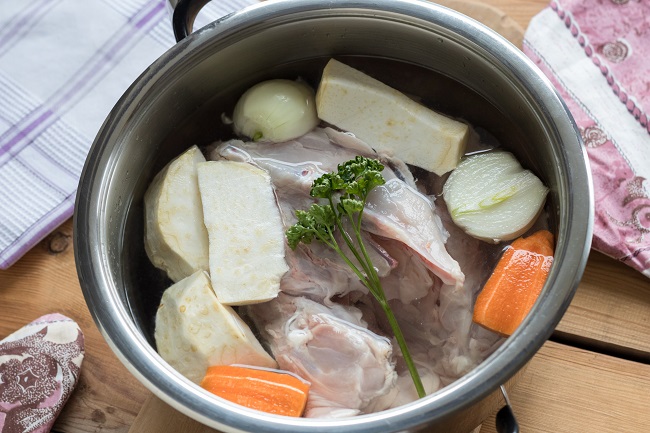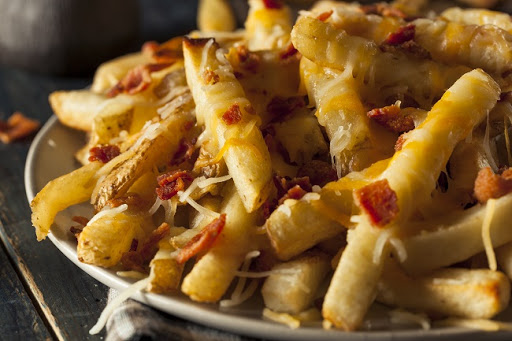As we all age, we lose the ability to produce collagen.
Collagen is the most common protein in the human body and provides the body’s structure and form. It is the majority of protein in our bones, skin, joints, teeth, arterial walls, and other organs which are vital to our health.
If collagen sounds important, it’s because it is. In fact, it’s often referred to as the body’s “glue,” because it literally holds us all together!
Unfortunately, the way we live in modern society has led to a decrease in consumption in gelatin/collagen as we no longer make our own organic bone broths or eat as many parts of animals as our ancestors did centuries ago.
This is creating a problem in terms of the degeneration of our hair, skin, nails, bones, joints and connective tissues of the body.
Those fine lines and wrinkles can’t just be attributed to genetics or sun exposure – the natural loss of collagen-producing ability plays a major part.
So How Exactly Do We Lose Collagen?
If collagen is the majority of protein in our bodies, and our bodies are full of protein, how is it possible that we actually lose it over time?
As amazing as the human body is, its science isn’t perfect. If it were, we probably would live forever! As you know, we can’t but we can rebuild our body’s collagen so it looks and feels like we can.
Like every other substance on and in our body, collagen is subject to the normal wear and tear that comes with aging. The first thing you probably noticed when you started to age was that your skin started developing fine lines (like “crow’s feet” and “laugh lines”) that eventually became wrinkles.
Skin cells called fibroblasts have the capabilities to produce collagen by replacing broken collagen fibers with new ones when needed. In a completely natural process over time, our skin’s ability to replace damaged and diminished collagen slows down and more gaps and inconsistencies in the collagen mesh develop. Hence, you get wrinkles.
Most skin care products only address the topical replenishment of collagen, claiming that your skin absorbs the collagen into your system. The surefire way for your skin to regain its elasticity – even partially – is by reducing collagen breakdown and increasing its supply.
Many factors contribute to collagen breakdown can actually be fully or partially neutralized. This includes common things like damage due to harmful UV rays and sun exposure, age-related hormone changes, free radicals, and smoking.
But there are many other factors, too.
How Does Changes In Our Diet Contribute To A Loss Of Collagen?
Chicken feet soup, blood pudding, and fermented horse milk may sound like something contestants are forced to eat on a game show, but they are actually common foods eaten around the world.
Our modern diet has greatly evolved from our ancestors’ traditional diets of various animals and their products. Many of the food we consume today didn’t even exist just a century ago, and we’ve cast aside foods that are rich in nutrition in favor of foods that have no nutritional value. This is mainly due to two factors: what we are told through ads/media and what is the quickest meal for our on-the-go lifestyle.
Dating back to 10,000 years to the start of the 20th century, our ancestors spent a good amount of time raising their own cattle (and other animals), humanely butchering it, and using just about the entirety of its body for consumption. Yes, it was time-consuming, and those that couldn’t raise livestock would hunt instead, but after that, the process was the same: the animal was carefully butchered so as much nutrition and meat was preserved and consumed as possible.
As much time as it took, people gained an appreciation for the entire animal and weren’t so quick to discard organs, skin, fat, and collagen-rich tissues.
Soup with whole chicken feet cooking in the broth was a common sight, even though by today’s standards it would be considered unsanitary and downright gross. To our ancestors, it was about survival, not what someone else thought of their soup ingredients.
What We Can Eat Now: 10 Foods To Help Boost Collagen Production
Around age 35 is when our collagen production begins to taper off and the collagen we do have is not the same quality it was just five years earlier. In addition to taking a total collagen supplement like Collagen Complete, food is a great way to help naturally boost collagen and its production.
Wisconsin plastic surgeon Richard C. Parfitt, MD says: “Stimulating collagen with at-home topical products, in-office treatments and proper lifestyle choices helps the skin maintain its strength, resiliency and volume.”
Here are 10 foods that will help the collagen-boosting process:
Red Vegetables – Tomatoes, peppers, and beets contain the antioxidant lycopene, which acts as a natural sunblock. It protects our skin from the damage of the sun while increasing collagen levels.
Dark Green Vegetables – These veggies are rich in Vitamin C and dark greens like spinach and kale can rev up collagen production. “Vitamin C has antioxidizing properties that stabilize the messenger enzymes that break collagen down. It also protects against free radicals to prevent weak collagen,” says Orlando, FL, dermatologist Dr. Dimitry Palceski.
Orange Vegetables – Carrots and sweet potatoes are rich in Vitamin A which restores and regenerates damaged collagen.
Berries – You probably know that berries are an excellent anti-antioxidant that are free radical scavengers, but blackberries and raspberries increase collagen levels in the process.
Soy – Soy is becoming an increasingly popular alternative to dairy and contains genistein – plant hormones that serve as antioxidants – which prompts collagen production and helps to block enzymes that can age the skin like MMPs (Matrix metalloproteinases).
White Tea – Research conducted by Kingston University and Neal’s Yard Remedies, suggests that “white tea may protect the structural proteins of the skin, specifically collagen.” White tea is also believed to prevent enzyme activity that breaks down collagen, weakening its mesh.
Citrus Fruit – Red, dark green, and orange vegetables have already been mentioned, but studies also show that citrus fruits like oranges, limes, lemons, and grapefruits that are rich in Vitamin C can help the amino acids lysine and proline convert to collagen. Vitamin C is also extremely important antioxidant in the fight to neutralize free radicals.
Protein – This should be a no-brainer after knowing that the collagen that is consumed either in a supplement like Collagen Complete or in topical treatment is extracted from animals. Because that’s where organic collagen comes from, it’s reasonable to suggest one of the 10 best foods you can eat to boost collagen production is protein itself! In addition to animal protein, eggs whites are high in amino acids as well as collagen itself. If you enjoy a vegan/vegetarian diet, nuts are another good source of lysine.
Garlic – Fans of a Mediterranean diet rejoice! Garlic is one of the best sources of sulfur, which is necessary to collagen production. It also provides lipoic acid and taurine that help rebuild damaged collagen fibers.
Oysters – Oysters are naturally rich in zinc, an essential element of collagen building. The exotic mollusk is also loaded with vitamins and minerals including Vitamin B12 and iron.
What Are Some Ways To Boost Collagen In Our Skin And Joints?
Although creams and ointments that claim they will add collagen to your skin have been around for decades, new collagen has to become a part of the dermis (the skin’s inner layer). The truth is that collagen molecules are too large to penetrate the dermis when applied topically. When applied in a cream, the collagen remains on the skin’s surface and doesn’t affect the skin structure which is the key to regaining some of the skin’s elasticity. If you have used these products and feel very strongly that you did see positive results, it’s because, at best, it moisturized your skin and temporarily filled in wrinkles.
The only proven way to boost collagen is from the inside – and consuming collagen or gelatin is the most natural and healthy way to do so without any of the drawbacks of the newly-popular injectables.
In addition to consuming a product like Collagen Complete, Vitamin C, amino acids, and the 10 foods mentioned above, there are other minerals essential for collagen production like copper. Copper peptides is the safest way to add copper for boosting collagen as it is a potentially toxic metal. It must be noted that supplements containing more than 2mg of copper (the recommended daily amount) should not be taken! Applying inorganic copper directly to the skin is also potentially harmful as inorganic copper promotes free radical formation. However, when copper is converted to organic form by binding to peptides (small protein fragments), it can be safely be applied to the skin with relatively low risk. Copper peptides, along the lines of creams and ointments, is effective in temporarily smoothing wrinkles and firming skin.
Today’s Society Is Laden With Inflammation-Causing Foods Giving People Unnecessary Arthritic Symptoms
Just as there are foods you should be eating that can help with the collagen replenishing process, likewise, there are foods that should be avoided because they cause inflammation which accelerates the aging process. In fact, inflammation causes a number of health issues like cardiovascular disease and arthritis.
The biggest hurdle in avoiding these foods is this simple rule: If it contains flour and/or sugar (or other sweeteners) it is pro-inflammatory. Not everyone is cut out for a gluten-free diet and avoiding any kind of sugar or sweetener entirely can be quite difficult. In excess, these are two of the main catalysts for weight gain and will make you look years older than your true age.
Here are some foods that you really should try your best to avoid and what you can try replacing it with:
Sugar – Instead try: A natural sweetener like stevia, honey, or blackstrap molasses. Another option if your sweet tooth is itching is fresh or dried fruits and fruit preserves without added sugar. They are naturally sweet and are chock full of vitamins, fiber, and antioxidants. Dates, figs, persimmons, kiwis, tangerines, and berries are some of the natural “candy” that will satisfy your sugar craving.
Common Cooking Oils – Instead try: Replace your omega-6-saturated cooking oils with macadamia oil, extra virgin olive oil, or other exotic oils like avocado, cold pressed coconut, macadamia, and almond oil (to name a few) oils. These oils tend to have a more balanced omega-6 or omega-3 fatty acids ratio.
Trans Fats – Instead try: Read the label! There are alternative products that contain no trans fats and don’t have partially hydrogenated oil or vegetable shortening, but you have to scour the ingredients list or nutritional chart on the packaging carefully. When in doubt, assume everything commercially processed contains trans fat unless they state otherwise.
Dairy – Instead try: Kefir (a popular health drink in many European countries including Finland, Hungary, Norway, Poland, Romania, Russia, Sweden and Ukraine) and unsweetened yogurt are acceptable in moderation. Both are easier on the digestive tract as the lactose and proteins have been broken down by beneficial bacteria and/or yeasts.
Feed-Lot Raised Meat – Instead try: Organic, free-range animals that are grass-fed and don’t consume large amounts of grains and hormones. These animal products contain more omega-3 fats and because they have more roaming room they are leaner with less saturated fats.
Alcohol – Instead try: A refreshing glass of pure, filtered water or a cup of jasmine green tea. Alcoholic beverages contain lots of harmful chemicals and the sugar content is through the roof. If you do care to drink at an event or to have a glass of wine after a long day, limit your consumption to just one drink.
Refined Grains – Instead try: Minimally processed grains. Today, this isn’t nearly as difficult to find as it was, say, a decade ago but you also have to be careful of companies jumping on the bandwagon and claiming their product is “whole grain” even when it isn’t. There isn’t an internationally accepted definition for the term and food manufacturers know this. For the most part, white rice, white flour, white bread, noodles, pasta, biscuits, and pastries and baked goods will all be processed unless they are specifically stated as not.
Artificial Food Additives – Instead try: Along with limiting your processed foods intake, use anti-inflammatory herbs, spices, or natural sweeteners to add flavor to your meals.
Conclusion
Due to a combination of normal aging, little to no consumption of bone and joint gelatin/collagen, and inflammation caused by the unhealthy “quick” foods we eat are all causes for an accelerated loss of collagen in our bodies, which age us faster.
Replacing the collagen we lose over time is important, but it is just as important to do our best to boost collagen production too. If we want our bodies to perform at their optimum level, we have to give them what they need to do so, and that all starts with the “glue” that’s holding it all together.



